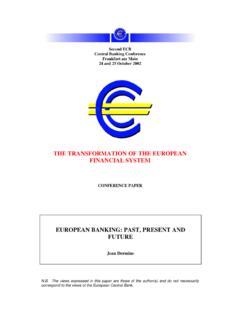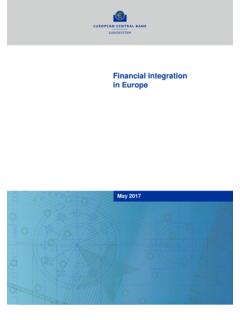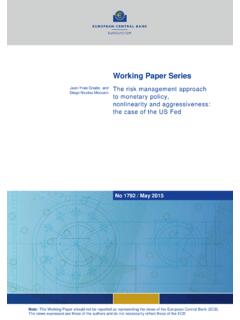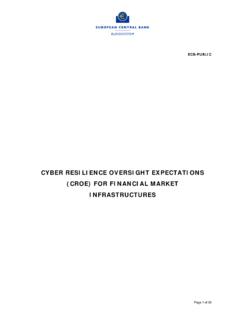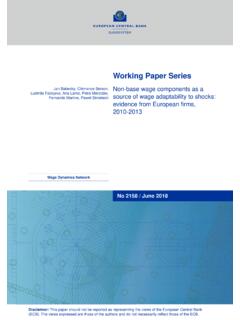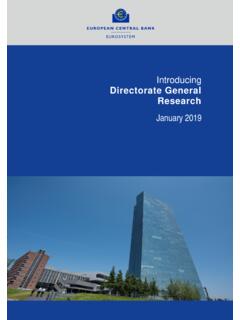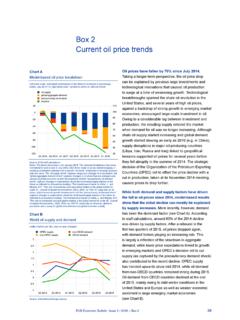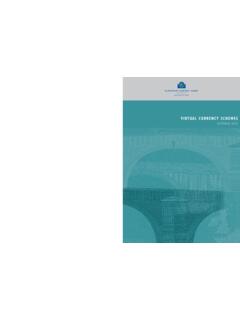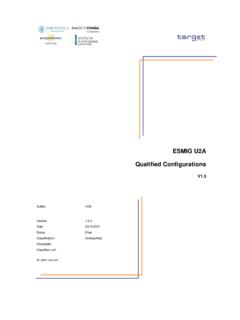Transcription of Climate-related risk and financial stability
1 Climate-related risk and financial stability ECB/ESRB Project Team on climate risk monitoring July 2021 Climate-related risk and financial stability Contents 1 Contents Executive Summary 3 1 Introduction 6 2 Physical risks 10 Physical risks for the financial system 10 Banking sector exposures to physical risks 11 Box 1 Deep dive flood risk in Europe 13 Insurers exposures to climate risks: a widening of the insurance protection gap? 20 Data gaps in exposure mapping 22 3 Transition risk exposure mapping 24 Banking sector exposures 24 Investment fund exposures 27 Insurance companies exposures 30 Box 2 Transition risks on balance sheets of occupational pension schemes 34 4 financial markets and climate risks 36 Climate risk pricing 36 Market mechanisms to mitigate climate risks 37 5 Climate risks evolution through the lens of macro- financial scenarios 41 Scenario narratives 41 Box 3 Assessing the long-term trade-offs and cost of inaction 45 Augmenting macro- financial and sector-level insights 47 6 Climate stress testing a new kid on the block 50 7 Developments in climate stress test methodologies 54 Box 4 Modelling loan defaults with individual bank -sector exposures 59 Box 5 Mapping macro- financial scenarios to firm-level data
2 61 Climate-related risk and financial stability Contents 2 Box 6 AnaCredit and modelling of credit risk parameters 63 8 Forward-looking scenario analysis of the European financial system 66 Box 7 Alternative climate-risk macro- financial scenarios 68 Banking sector 69 Insurance sector 71 Investment funds 73 Early conclusions 77 Box 8 Amplification of climate scenarios in an interconnected financial system of banks and investment funds 79 Box 9 Stress testing and impact assessment of the high-emitting penalising factor 80 9 Conclusions 83 References 85 Annex 1: Overview of climate risk stress-testing and sensitivity exercises 91 Annex 2 Detailed look at existing methodologies: Handbook 97 Credit risk in the banking book 97 Revaluation losses 102 Physical risk in the insurance sector 107 Sector-level scenario elements 108 Imprint and acknowledgements 110 Climate-related risk and financial stability Executive Summary 3 Executive Summary The impacts of climate change on financial stability hinge on both the distribution of financial exposures and the evolution of prospective financial system losses.
3 A first challenge to accurately sizing impacts in this respect is exposure granularity fine resolution measurement is required to trace out heterogeneous and novel physical and transition risk impacts across geographies, sectors and A second challenge is the unprecedented nature, including long-dated horizon, of climate risk necessitating innovation in forward-looking modelling to identify prospective financial losses. T his report tackles both challenges, unveiling an analysis of a broadened set of climate change drivers over long-dated financial risk horizons, with the aim of providing a more encompassing and robust quantification of financial stability risks in the European Union to underpin targeted and effective policy action. A granular mapping of financial exposures to climate change drivers suggests uneven vulnerability across EU regions, sectors and financial institutions.
4 A mapping of the physical risks of climate change requires geolocated hazards to be linked to economic and financial risk exposures. An analogous mapping of the transition risks of climate change requires an encompassing view of exposures to carbon emissions across the entire value chain, including downstream emissions, as financial markets continue to rapidly green. While subject to measurement uncertainty, three forms of risk concentration emerge from this granular mapping. Exposures to physical climate hazards are concentrated at the regional level, with potential stranding risks. A matching of physical risk drivers to million euro area firms at the address level shows that riverine floods are the most economically relevant widespread climate risk driver in the EU over the next two decades. Wildfires, heat stress and water stress could have a strong impact on some regions, possibly compounded by further stresses such as rising sea levels in the second half of this century.
5 Ultimately, a coalescing of such natural hazards could impact up to 30% of euro area bank corporate exposures. Systemic amplifiers leading to potential stranding could follow from two sources. A first is interactions with existing financial vulnerabilities, noting that exposures appear to be more relevant for weakly capitalised and/or less profitable banks. A second and perhaps even more concerning systemic amplifier relates to protection gaps. On the one hand, physical collateral, backing the majority of collateralised exposures, may itself be compromised by climate hazards, thereby subject to wrong way risk . On the other hand, insurance might not represent a buffer, particularly in a systemic shock with widespread impacts on affordability or coverage, given that only 35% of economically relevant climate losses on average are estimated to be currently insured in the EU.
6 1 A detailed gap analysis, framing the focus of this report, is contained in: ESRB (2020), Positively green: Measuring climate change risks to financial stability . Climate-related risk and financial stability Executive Summary 4 Exposures to emissions-intensive firms are concentrated not only across but also within economic sectors, leaving parts of the financial system vulnerable to potentially destabilising financial market corrections. A matching of all scopes of firm greenhouse gas (GHG) emissions to over million euro area firms suggests that exposures to high-emitting firms represent 14% of collective euro area banking sector balance sheets mainly concentrated in the manufacturing, electricity, transportation and construction sectors. Exposures vary greatly not only across economic sectors, but also within them losses related to the highest emitting firms could constitute an estimated 10% of bank balance sheets in the event of credit rating downgrades associated with a rapidly rising carbon price to Paris-aligned levels.
7 In the case of investment funds, portfolio greening needs are even greater with over 55% of investments tilted towards high-emitting firms and an estimated alignment with the EU Taxonomy at only 1% of assets. As for insurers, while direct holdings are contained, they could be amplified by investment fund cross-holdings of around 30%. Such impacts could be particularly pronounced should financial markets abruptly reprice the financial risk associated with climate change against a backdrop of rapid market growth of green finance and environmental, social and governance (ESG) investing despite still limited disclosures, standards and taxonomies. Exposures to climate risk drivers are also concentrated in specific European financial intermediaries. With regard to physical risk, 70% of banking system credit exposures to firms subject to high or increasing physical risk hazards over the next decades are concentrated in the portfolios of only 25 banks.
8 For tr ansition risk, many EU investment funds may be subject to increased scrutiny noting that, on average, only 11% of portfolios can currently be considered as green. Long-term scenario analysis for EU banks, insurers and investment funds suggests credit or market risk losses from an insufficiently timely or effective climate transition. Three climate scenarios drawn from the Network for Greening the financial System (NGFS) are explored, examining both physical and transition risk drivers as well as assumptions on climate technologies: a reference orderly scenario of timely policy adjustment complemented by effective carbon dioxide removal technologies, against a destabilising disorderly transition and a hot house world physical risk-laden outcome. The scenarios are translated into actionable form by leveraging the granular risk mapping and transposing macroeconomic model outputs to 55 economic sectors and numerous regions.
9 The scenarios are then run through stress test models for banks, insurers and investment funds. A consistent finding is that credit and market risk could cumulate from a failure to effectively counteract global warming. Notwithstanding uncertainties around methodologies analysing such long-dated horizons, scenarios indicate that physical risk losses particularly for high-emitting firms would become dominant in around 15 years in the event of an insufficiently orderly climate transition, with falls of up to 20% in global GDP by the end of the century should mitigation prove to be insufficient or ineffective. Climate-related risk and financial stability Executive Summary 5 EU banking sector credit risk losses under adverse climate scenarios could amount to of corporate risk-weighted assets in a 30-year timeframe.
10 Such a magnitude is around half that of adverse scenarios used in conventional macroeconomic stress test exercises (albeit with a far shorter horizon). A hot house world scenario leads to more financial system losses than a disorderly transition scenario both in the sectoral concentration of bank losses (with electricity and real estate together accounting for over half of the total impact) and in the broader distribution of bank level losses. EU insurance sector market risk revaluation losses could be material in key climate-sensitive sectors for corporate equity and, to a lesser extent, corporate bond investments over the next 15 years under a disorderly transition scenario. While average impacts are quite modest, amounting to about 5 percentage points above a reference orderly adjustment scenario, modelling using sector-level production plans and technologies suggests particularly large losses of 15% for equity holdings in oil, gas and vehicles.
